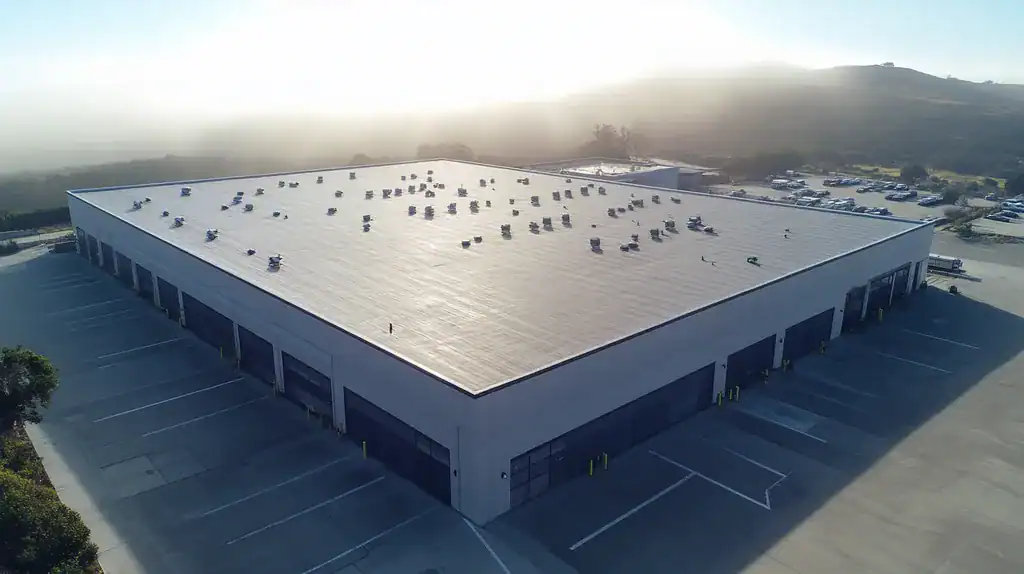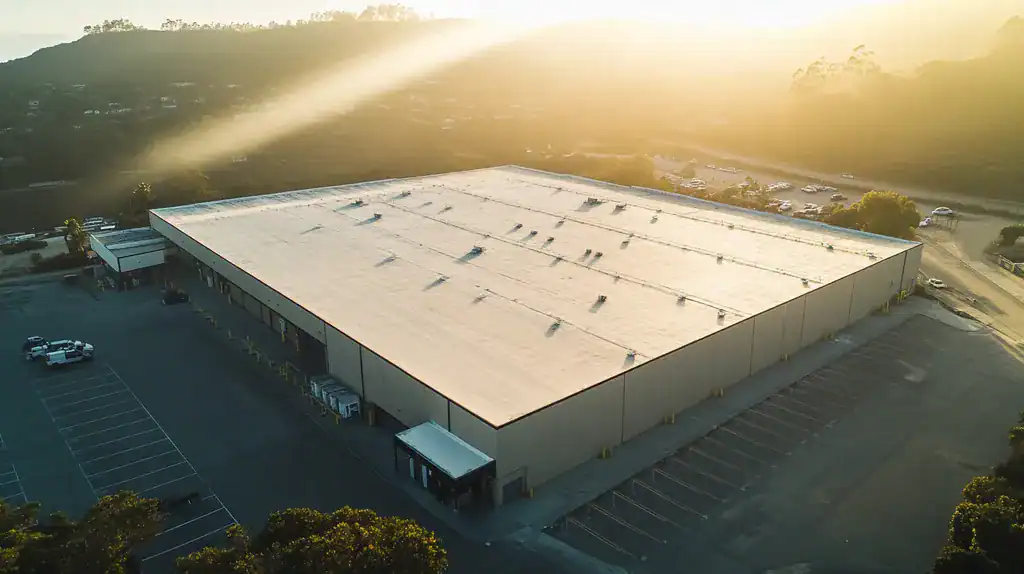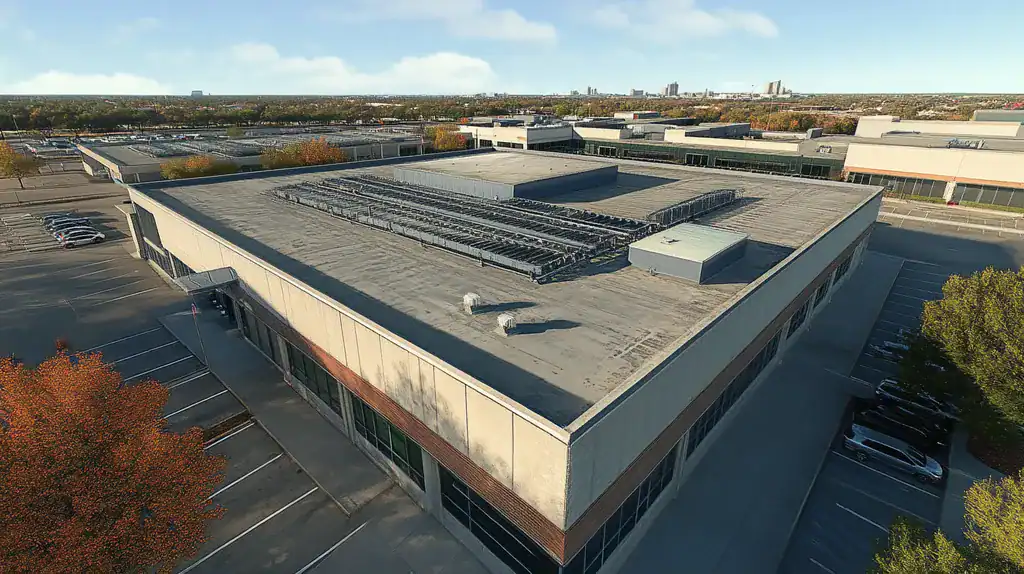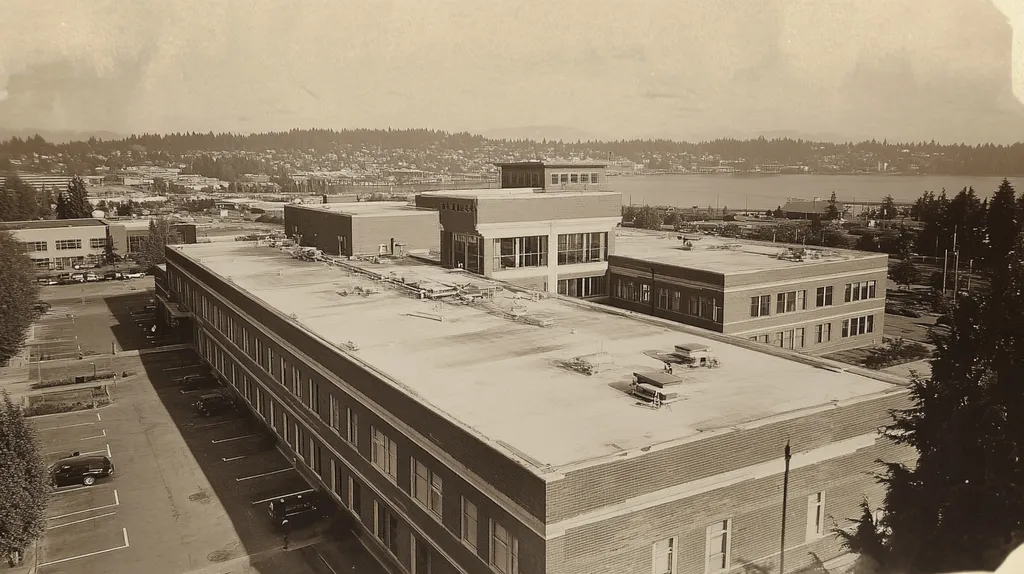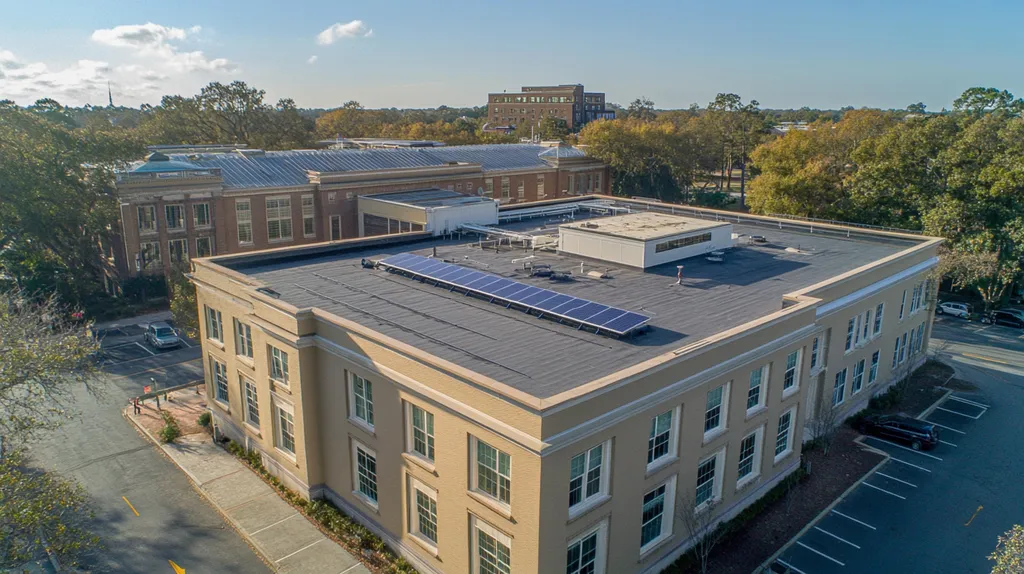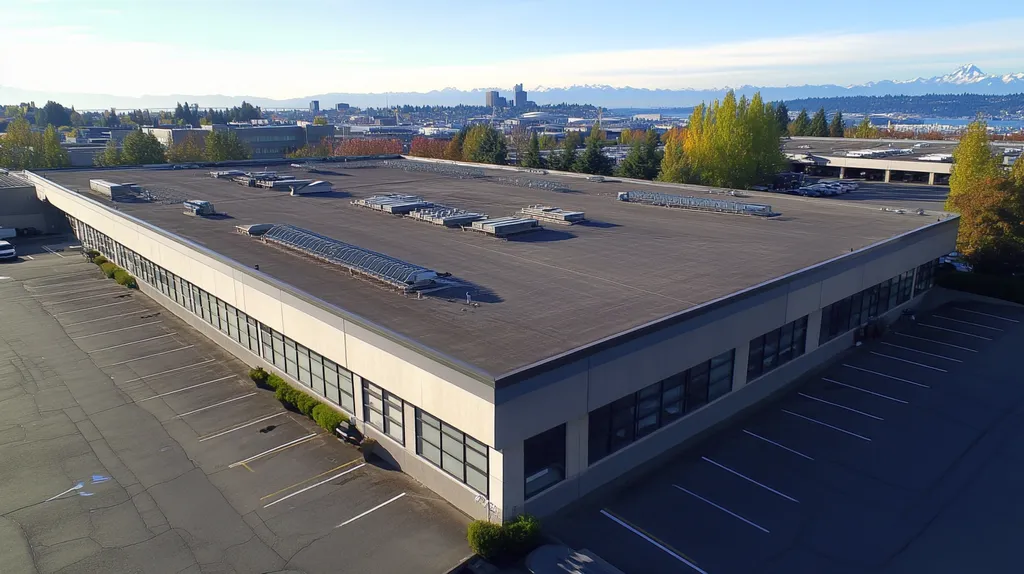Every year, falls from industrial roofs claim dozens of lives and result in millions of dollars in damages, making proper safety protocols not just a legal requirement, but a business imperative.
Statistics show that 34% of all construction fatalities stem from preventable roofing accidents, while OSHA violations related to fall protection consistently rank as the most cited workplace safety infractions.
This comprehensive guide examines critical safety measures for industrial roofing projects, from essential fall protection systems to proper material handling protocols, providing facility managers with actionable strategies to protect both workers and assets.
SECTION 1: THE BASICS EXPLAINED
Industrial roofing projects present significant safety challenges that demand rigorous attention. Statistics show that falls from heights remain the leading cause of fatalities in construction, with roofing work being particularly hazardous. Without proper safety measures, even routine maintenance can lead to catastrophic accidents, resulting in injuries, deaths, and substantial financial liability.
What It Is (In Plain Language)
Safety measures for industrial roofing constitute a comprehensive system of physical barriers, protective equipment, and work procedures. These include warning lines, safety harnesses, guardrails, and proper material handling protocols.
OSHA mandates that warning line systems must be installed at least 6 feet from roof edges, while all covers must support double the weight of workers, equipment, and materials that may be placed on them. A qualified safety monitor must oversee all roofing operations to ensure compliance. (source: OSHA)
These measures create multiple layers of protection, working together to prevent accidents before they occur. They include both passive systems that provide constant protection and active measures requiring worker engagement.
Each safety component serves a specific purpose, from fall prevention to proper material storage, forming an interconnected web of protection that covers all aspects of roofing work.
Why It Matters (To Your Building)
Proper safety measures protect more than just workers – they safeguard your entire operation. A single roofing accident can halt projects, trigger OSHA investigations, and result in substantial fines.
Insurance premiums often spike following safety incidents, while worker’s compensation claims can impact budgets for years. Legal liability from accidents can threaten an organization’s financial stability.
Safety violations can damage your building’s reputation and relationship with contractors. Quality roofing companies may decline to bid on projects where safety isn’t prioritized.
Maintaining strong safety protocols helps ensure project completion on schedule and within budget, while protecting your investment in both human capital and physical assets.
How It Works
Effective safety implementation begins with thorough planning and site assessment. This includes identifying potential hazards, establishing work zones, and determining appropriate safety equipment requirements.
Daily safety briefings ensure all workers understand their responsibilities and current site conditions. Equipment inspections verify that all protective systems remain in proper working order.
Continuous monitoring throughout the project ensures compliance with established protocols. Regular safety audits identify potential issues before they become problems.
Documentation of all safety measures provides accountability and helps refine procedures for future projects. This systematic approach creates a culture of safety that becomes self-reinforcing over time.
SECTION 2: PRACTICAL APPLICATIONS
Industrial roofing safety measures can mean the difference between life and death. Every year, hundreds of preventable accidents occur due to inadequate safety protocols, with falls remaining the leading cause of fatalities. Understanding how to implement safety measures effectively across different scenarios and conditions is critical for protecting workers and maintaining operational continuity.
Common Uses & Examples
Warning line systems represent a fundamental safety measure, requiring installation at least 6 feet from roof edges with high-visibility flags every 6 feet. These systems must withstand 16 pounds of force without tipping, while covers protecting skylights must support double the anticipated load of workers and equipment. (source: OSHA)
Fall protection systems include guardrails, safety nets, and personal fall arrest equipment. These measures work together to create multiple layers of protection, especially during high-risk activities like material transportation and equipment installation.
Designated work zones help control access to hazardous areas and manage traffic flow across the roof surface. Clear markings and barriers prevent unauthorized entry while ensuring workers maintain safe distances from edges and openings.
Weather protection measures such as non-slip surfaces and proper drainage systems help maintain safe working conditions even during adverse conditions.
When You Need It Most
Critical phases requiring heightened safety measures include initial tear-off operations when the roof surface becomes unstable. During these periods, additional fall protection and debris containment systems become essential.
Material handling operations demand particular attention, as moving heavy equipment and supplies creates additional risk factors. Proper lifting protocols and equipment placement strategies help prevent strain injuries and falling object hazards.
Emergency response scenarios require clearly marked access points and evacuation routes. These pathways must remain unobstructed throughout the project duration.
Night work and low-visibility conditions necessitate enhanced lighting systems and reflective safety equipment. These measures ensure workers can identify hazards and maintain proper positioning at all times.
Interactions With Other Systems
Safety measures must integrate seamlessly with existing building systems, including access points, mechanical equipment, and emergency infrastructure. This coordination prevents conflicts that could compromise worker protection.
Communication networks link safety monitors with work crews, ensuring rapid response to changing conditions. These systems enable real-time adjustments to safety protocols as needed.
Material storage and handling systems require careful placement to maintain clear safety zones. Proper organization prevents congestion that could force workers into unsafe positions.
Documentation and monitoring systems track compliance with safety requirements while identifying potential improvements. This data helps refine safety protocols for future projects.
SECTION 3: KEY TERMINOLOGY DECODED
Clear understanding of roofing terminology directly impacts worker safety and project outcomes. When terms are misinterpreted or misunderstood, the consequences can be severe – from incorrect material specifications to life-threatening safety violations. Every year, roofing projects fail or face severe delays due to miscommunication and terminology confusion between facility managers, contractors, and work crews.
Essential Terms Explained
Fall protection terminology requires particular attention due to its direct safety implications. Warning line systems, guardrails, and personal fall arrest systems each have specific technical requirements that must be precisely understood.
OSHA mandates that warning line systems must be installed at least 6 feet from roof edges and flagged every 6 feet with high-visibility material. These systems must withstand 16 pounds of force, while covers protecting roof openings must support twice the anticipated load. (source: OSHA)
Load-bearing terminology describes how much weight different roof areas can safely support. Understanding terms like “dead load” (permanent weight) versus “live load” (temporary weight from workers, equipment, and materials) is crucial for preventing structural failures.
Weather resistance terms include “water penetration resistance,” “wind uplift,” and “impact resistance.” These measurements determine how well roofing systems withstand environmental stresses.
Industry Jargon Translated
Common roofing terms often have precise technical meanings that differ from everyday usage. “Membrane” refers to the waterproof barrier, while “substrate” describes the surface beneath roofing materials.
Installation-specific terminology includes “mechanically fastened,” “fully adhered,” and “ballasted” – each describing different methods of securing roofing materials. Understanding these distinctions prevents specification errors.
Safety-related jargon includes “competent person,” “controlled access zone,” and “leading edge.” These terms have specific legal and practical implications for worker protection.
Maintenance terminology such as “preventive,” “predictive,” and “reactive” maintenance describes different approaches to roof care, each with distinct scheduling and resource requirements.
Measurement & Units Simplified
Area measurements in roofing use “squares” (100 square feet) rather than standard square footage. This industry-specific unit helps standardize material ordering and cost estimation.
Slope measurements use ratio expressions like “4:12” (rising 4 inches for every 12 inches of horizontal distance). Understanding these ratios is essential for proper drainage and safety requirements.
Thermal measurements include R-value (insulation effectiveness) and U-value (heat transfer rate). Higher R-values indicate better insulation, while lower U-values show better thermal resistance.
Load calculations use pounds per square foot (PSF) to specify weight limits. These measurements must account for both permanent installations and temporary loads during construction or maintenance.
SECTION 4: DECISION FACTORS
Making informed decisions about industrial roofing safety measures can mean the difference between project success and catastrophic failure. Statistics show that inadequate safety planning leads to 34% of roofing project delays and cost overruns. Each decision point – from initial material selection to ongoing maintenance protocols – carries implications for worker safety, building protection, and long-term performance.
Cost Considerations
Initial safety equipment expenses typically represent 15-20% of total project costs. However, these upfront investments prevent accidents that could result in project shutdowns, OSHA fines, and legal liability.
Safety measure costs must factor in both equipment purchases and ongoing training requirements. Quality fall protection systems and proper safety monitoring equipment provide returns through reduced insurance premiums and workers’ compensation claims.
Budget planning should include contingencies for weather delays and additional safety requirements. Projects that cut corners on safety often face expensive mid-project corrections when violations are discovered.
Life-cycle cost analysis reveals that comprehensive safety measures actually reduce total project expenses. The cost of accident prevention is always lower than the cost of accident response.
Performance Trade-offs
Warning line systems provide essential fall protection but can impact worker mobility and productivity. Lines must be installed at least 6 feet from roof edges and withstand 16 pounds of force without tipping, while hole covers must support double the anticipated load of workers and equipment. (source: OSHA)
More restrictive safety measures generally result in slower project completion times. However, this trade-off is essential for maintaining worker protection and regulatory compliance.
Some safety equipment may limit access to certain roof areas or require additional setup time. These limitations must be factored into project scheduling and workflow planning.
Enhanced safety protocols can actually improve overall performance by reducing accident-related delays and ensuring consistent work quality.
Lifespan & Durability Factors
Safety equipment durability directly impacts long-term effectiveness and replacement costs. Quality fall protection systems typically maintain their integrity for 5-7 years with proper maintenance.
Environmental exposure accelerates wear on safety equipment. Regular inspections and maintenance programs help identify potential failures before they create hazards.
Storage and handling procedures significantly affect equipment lifespan. Proper cleaning, storage, and maintenance protocols protect safety investments and ensure reliable performance.
Documentation of equipment age and inspection history supports timely replacement planning. This proactive approach prevents safety systems from degrading below acceptable standards.
SECTION 5: COMMON CHALLENGES
Industrial roofing projects face a complex array of challenges that can compromise safety and project success. Recent industry data shows that over 60% of roofing accidents stem from previously identified but unaddressed hazards. From equipment failures to weather complications, these challenges require systematic approaches to maintain worker safety and project integrity. Understanding and preparing for common obstacles is essential for preventing costly delays and dangerous conditions.
Frequent Problems & Solutions
The most prevalent challenges include deteriorating safety equipment, inadequate fall protection systems, and improper material storage. OSHA requires warning line systems to be erected at least 6 feet from roof edges, with flags every 6 feet, and capable of withstanding 16 pounds of force without tipping. Additionally, covers protecting roof openings must support twice the anticipated load of workers and equipment. (source: OSHA)
Equipment malfunctions frequently disrupt project timelines and create hazardous conditions. Regular inspection schedules and preventive maintenance programs help identify potential failures before they occur.
Weather-related challenges can significantly impact both safety conditions and work progress. Implementation of proper drainage systems and non-slip surfaces helps maintain safe working conditions during adverse weather.
Communication breakdowns between crews and safety monitors create dangerous situations. Establishing clear protocols and maintaining open channels helps prevent misunderstandings that could lead to accidents.
Warning Signs To Watch For
Structural indicators like excessive deflection or visible damage demand immediate attention. These signs often precede more serious failures that could compromise worker safety.
Changes in equipment performance, including unusual noises or decreased efficiency, signal potential safety issues. Prompt investigation of these changes can prevent dangerous equipment failures.
Worker fatigue and decreased attention to safety protocols indicate potential systemic problems. Regular safety audits help identify these behavioral changes before they result in accidents.
Environmental factors such as pooling water or ice formation require immediate response. These conditions create slip hazards and can compromise the integrity of safety systems.
Preventative Approaches
Comprehensive safety training programs form the foundation of accident prevention. Regular updates and refresher courses ensure all workers maintain current knowledge of safety requirements.
Technology integration, including digital monitoring systems and automated safety checks, enhances hazard detection. These tools provide early warning of developing problems.
Documentation systems track inspection results and maintenance activities across all safety equipment. This data helps identify patterns and predict potential failures.
Regular safety audits verify compliance with established protocols and identify areas for improvement. These assessments help maintain high safety standards throughout project duration.
SECTION 6: NEXT STEPS & RESOURCES
Industrial roofing safety represents a critical investment that demands thorough understanding and careful implementation. Recent data shows that 75% of roofing accidents occur on projects where basic safety protocols were overlooked or improperly executed. For facility managers and property owners, taking the right next steps can mean the difference between project success and catastrophic failure.
Questions To Ask Providers
Start by verifying a contractor’s safety training program and certification status. Request detailed documentation of their safety protocols, incident records, and emergency response procedures.
Examine their equipment maintenance schedules and inspection protocols. Quality contractors maintain comprehensive records and can demonstrate regular safety audits.
Discuss their specific approach to fall protection systems and how they’ll implement them on your project. Their response should align with current safety standards and demonstrate thorough understanding.
Verify their insurance coverage and safety compliance history. Top providers maintain clean records and carry appropriate coverage levels for industrial projects.
Industry Standards & Guidelines
For roofs over 6 feet above lower levels, warning line systems must be erected at least 6 feet from roof edges and flagged with high-visibility material every 6 feet. Covers protecting roof openings must support twice the weight of workers and equipment that may be placed on them. (source: OSHA)
The National Roofing Contractors Association provides updated technical bulletins and safety guidelines. These resources offer crucial insights into evolving safety standards.
Regional building codes often exceed federal requirements. Understanding local regulations helps ensure complete compliance and avoid costly violations.
Industry certification programs provide standardized metrics for evaluating safety protocols. These benchmarks help measure contractor qualifications objectively.
Further Learning Simplified
Professional development courses focused on industrial roofing safety offer structured learning paths. These programs typically cover risk assessment, emergency response, and safety system implementation.
Trade associations provide specialized workshops and seminars throughout the year. These events deliver practical knowledge and networking opportunities with safety experts.
Online learning platforms offer flexible access to safety training materials. Digital resources allow teams to maintain current knowledge while accommodating work schedules.
Safety technology webinars showcase emerging tools and techniques. These presentations help facilities managers stay informed about innovations in roof safety.
The Bottom Line
Every year, preventable roofing accidents claim dozens of lives and cost the industry billions in damages, fines, and legal settlements.
With 34% of construction fatalities stemming from falls, implementing comprehensive safety measures isn’t just a regulatory requirement—it’s a business imperative that directly impacts project success and organizational survival.
The evidence is clear: companies that invest in proper safety protocols, from warning line systems to fall protection equipment, consistently deliver projects on time and under budget while maintaining worker safety.
Those who cut corners on safety measures face devastating consequences, from OSHA violations and insurance premium spikes to catastrophic accidents and permanent facility closure.
The choice between safety compliance and risk is no choice at all—it’s the difference between operational excellence and organizational failure.
FREQUENTLY ASKED QUESTIONS
Q. What are the basic safety measures for commercial roofs?
A. Safety measures for commercial roofs include warning systems, harnesses, and guardrails. Proper procedures and equipment are essential for preventing accidents and ensuring worker safety on site.
Q. How can I implement safety measures in industrial roof projects?
A. Implementing safety measures involves establishing high-visibility warning lines, managing access to high-risk areas, and utilizing fall protection equipment. Regular training on these systems is crucial for compliance and safety.
Q. What roofing terminology should I know for commercial roof safety?
A. Key terms include fall protection systems, load-bearing terminology, and weather resistance measures. Knowing these terms prevents miscommunication about safety protocols and material specifications.
Q. What factors influence decisions for industrial roof safety?
A. Decision factors include the cost of safety equipment, performance trade-offs, and the expected lifespan of safety systems. Balancing cost and safety effectiveness is essential for successful project outcomes.
Q. What common challenges do commercial roof projects face?
A. Common challenges include deteriorating equipment, communication breakdowns, and weather-related hazards. Proactive measures and safety training can help mitigate these issues and enhance worker safety.
Q. What should I ask contractors about industrial roof safety?
A. Verify their safety training programs, equipment maintenance practices, and incident records. A reputable contractor should clearly outline their safety protocols for your project.
Q. How can I stay updated on roofing safety standards?
A. Attend industry workshops, enroll in professional development courses, and follow trade associations for updates. These resources can enhance understanding of current safety practices and guidelines.

